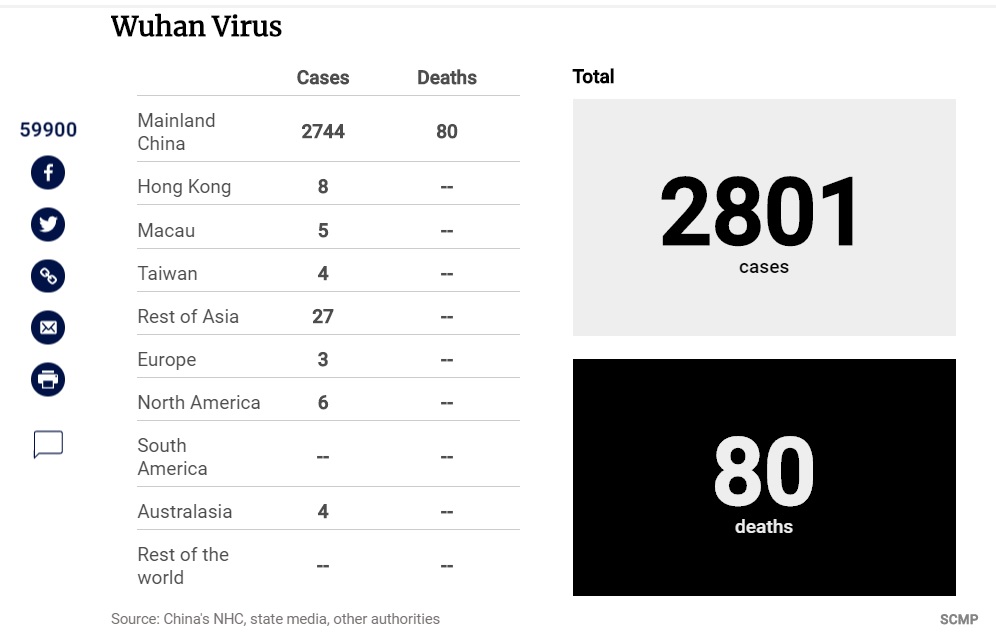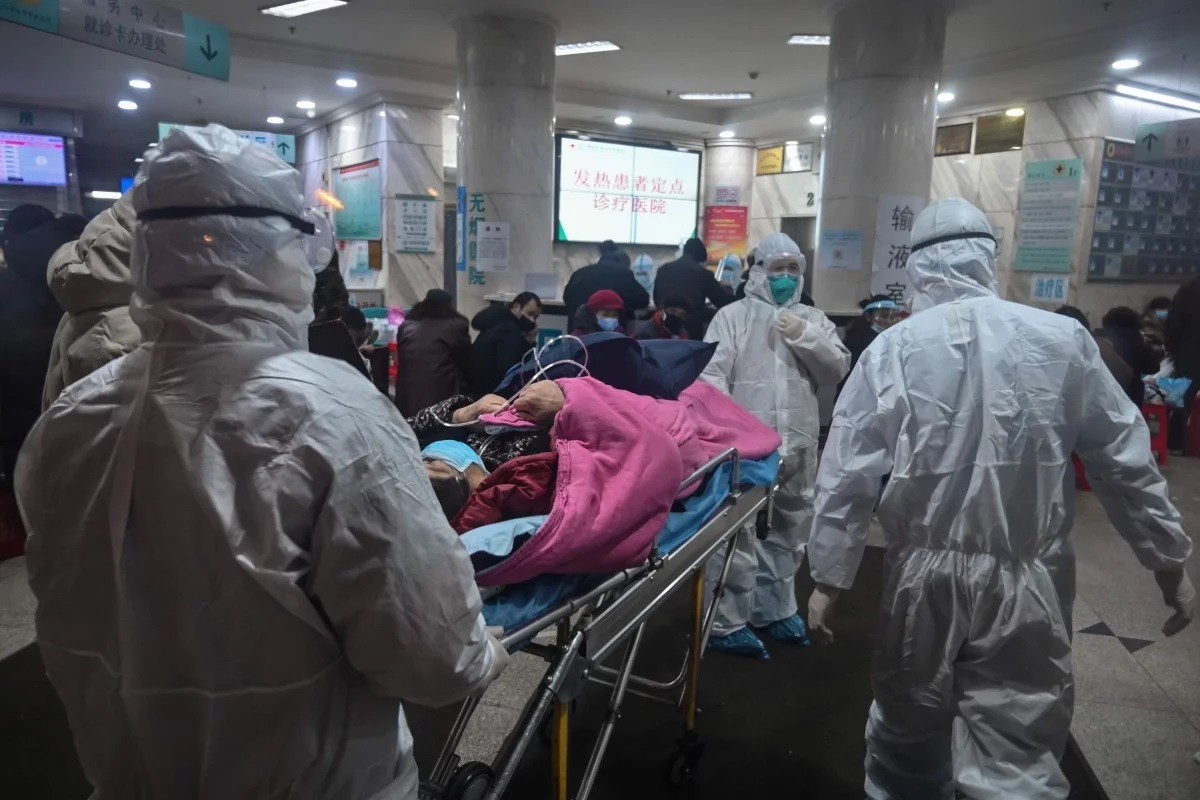- Health commission says battling the epidemic is becoming more complicated as the Chinese State Council extends the Lunar New Year holiday to February 2
- Chinese premier to head coronavirus crisis team as outbreak worsens
About 5 million residents left Wuhan before the lockdown because of the deadly coronavirus epidemic and the Spring Festival holiday, mayor Zhou Xianwang revealed on Sunday, as health officials warned the virus’ ability to spread was getting stronger.
There were about 9 million people remaining in the city after the lockdown, Zhou told a press conference.
Of the 2,700 people currently under observation in the city, about 1,000 were likely to be confirmed cases. As of Sunday, Wuhan had 533 confirmed cases.
The central government imposed a lockdown on Wuhan and several cities on Thursday hoping to stop the new virus from spreading to other parts of the country. However, many had already left the city for the holiday, while others rushed out after the lockdown was announced on Wednesday night
Beijing city reported five more confirmed cases, including a nine-month-old infant. It is the first confirmed infant case. On Saturday, a two-year-old girl in Guangxi was confirmed to be infected.
The Chinese State Council has extended the Lunar New Year holiday to February 2 to curb the spread of the virus, according to state broadcaster CCTV. The holiday, which was initially supposed to last until January 30, is the country’s most important festival and hundreds of millions of rural migrant workers nationwide travel home for it.
Suzhou was the first city to announce a holiday extension, saying workers at companies within its jurisdiction should resume work no earlier than February 8.
The State Council also said that kindergartens, primary and secondary schools, and colleges will be suspended until further notice from the education ministry.
“From observations, the virus is capable of transmission even during incubation period,” Ma said, adding that the incubation period lasted from one to 14 days.
“Some patients have normal temperatures and there are many milder cases. There are hidden carriers,” he said.

Ma said also that the virus had adapted to humans and appeared to have become more transmissible.
“There are signs showing the virus is becoming more transmissible. These walking ‘contagious agents’ [hidden carriers] make controlling the outbreak a lot more difficult.”
The authorities had also not ruled out the possibility of the virus mutating in the future, he said, which meant it could spread to different age groups.
To date, most of the people infected are in the 40-60 age range, health officials said earlier.
Sars, which killed more than 800 people and infected over 8,000 around the world, typically had an incubation period of two to seven days, and was not infectious during that time.
University of Hong Kong microbiologist Yuen Kwok-yung said that how transmissible the virus was during its incubation period depended on the “viral load” in each infection.
“If I sneeze on you point blank, you may get a fever and pneumonia tomorrow too,” he said.
Ma said that the epidemic was accelerating and “may last for some time”.
“It is possible that there will be more cases,” he said.
Speaking to the press on Sunday, Gao Fu, head of the Chinese Centre for Disease Control and Prevention, said the peak of the outbreak had yet to come.
“There are trends for an epidemic cycle,” he said. “It is still growing.”
However, he said there had yet to be any signs of the virus mutating
Li Bin, deputy minister of the NHC said the authorities that the severe measures they had taken to control the spread of the virus – such as issuing travel bans and locking down cities – would at least delay the peak and “buy time to combat the next stage of the outbreak”.
China has closed off 13 cities in Hubei province, which is at the epicentre of the outbreak, while almost the entire country has declared an emergency response.
Of all of China’s confirmed infections, more than half are in Hubei.
To help tackle the epidemic, Ma said that 2,360 military and civilian doctors and nurses had been sent to Wuhan, the city in which the outbreak was first detected at the end of last month.
As the pressure has mounted on the city’s hospitals, the medical system has moved ever closer to collapse.
Many people who developed feverish symptoms were turned away by hospitals earlier in the week because there were not enough beds, local residents said earlier.
Medical practitioners are also running seriously short of protective kits and are being forced to recycle goggles and masks.
Ma said 2,400 hospital beds had been added in Wuhan, and the government was planning to add 5,000 more over the next three days.
Wang Jiangping, China’s vice-minister of industry and information technology, said China had the capacity to produce a maximum of 30,000 protective outfits per day, but that was less than a third of what was needed in Hubei.
And during the Lunar New Year holiday, manufacturing capacity was only about 40 per cent of normal, he said.
The government was working to acquire the 50,000 protective jackets China produces for export every day to send to Hubei, he said.
However, the civil affairs ministry issued a statement on Sunday banning charity organisations and NGOs from sending teams to Hubei.
Any donations should be sent to government-sanctioned charity organisations in Hubei, such as the Red Cross, and they would be allocated by the Hubei and Wuhan governments as appropriate.
The NHC also issued a nationwide plan on containing the epidemic by locking down certain neighbourhood communities in both urban and rural areas.
In the case of a neighbourhood community or village having two confirmed cases, it could be declared an epidemic zone and sealed off, it said.
A Wuhan resident, who declined to be named, said that checkpoints had been set up in some communities on Sunday. People who had fever symptoms were being screened by medical workers within the community and those needed more attention were sent to hospital, he said.
China also imposed a nationwide ban on wildlife trade on Sunday. The outbreak is suspected to have originated at a seafood market in Wuhan, which also sold wild animals.
However, a research paper published by medical journal The Lancet on Saturday said the first confirmed case of the viral infection was a person who had not been to that market.
When asked if China planned to expand its travel ban to more cities, Li said the authorities would make adjustments as necessary.
China is hoping the travel bans will reduce the spread of the outbreak. As a result of the restrictions, rail passenger numbers have fallen by 41 per cent, road travellers by 25 per cent and air passengers by almost 42 per cent on Saturday, the first day of the Lunar New Year.
Meanwhile, the United States, France, Australia, Japan and Russia are all preparing to pull their citizens out of Wuhan, while others are ramping up measures to prevent people travelling from infected cities into their territories. Health officials in the US confirmed early Monday the fourth and fifth cases there, one in Los Angeles County, California and the other in Arizona. Both patients had traveled to Wuhan.
The ABC reported that more than 100 Australian children were currently trapped in Wuhan.

 3
3 